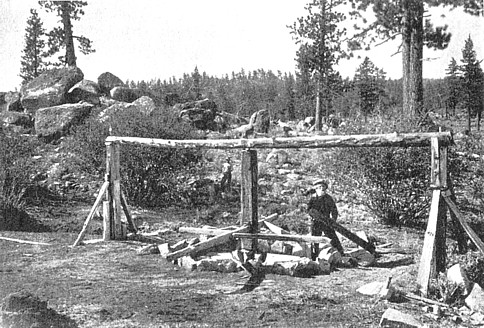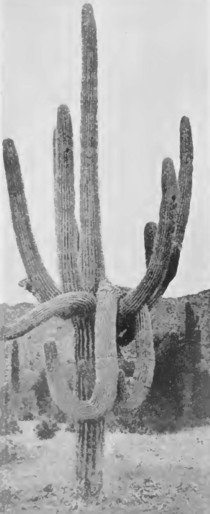The most notable general characteristics of the Arizona lodes would seem to be the great extent of mineral bearing lands, the extremely varied and complicated nature of the deposits, and their extraordinary richness, especially on and near the surface. No description even en resume is possible within my limits. Arizona resembles a kind of laboratory where nature has tried experiments preliminary to a general distribution of minerals in the Pacific states. The experienced miner from abroad is puzzled by the array of new combinations and strange geologic conditions, though he generally finds, sooner or later, all that he has known in other states. To a greater extent than in other regions, rich veins near the surface have been worked on a small scale, but profitably, by individuals with limited capital; but the prospects for deep mining in the future are understood to be encouraging on the whole. The natural facilities for mining, in the supply of wood and water—except in a few sections, and for placer mines—and especially in climate for continuous working, are excellent in comparison with those of other states; while agricultural resources more than suffice for the support of a dense mining population. Of the whole area, about 72,000,000 acres, nearly one half is described as mineral bearing.
Ores producing from $1,000 to $20,000 per ton in native gold and silver ore have been of frequent occurrence; but here, as elsewhere, such are not the deposits that promise the greatest permanent results. Nowhere has more money been wasted in blundering mismanagement; and even rascality in certain directions has not been wanting; yet Arizona has not been famous as the field of stock-board swindles; and her record has been for the most part one of dividends rather than assessments. In the north-eastern section of the territory, the region tributary to the Colorado, above the big bend, an area of about 40,000 square miles out of the entire 100,000, including northern Mojave, about three fourths of Yavapai, and nearly all of Apache counties, no rich deposits of the precious metals have been found; yet the extreme north-east, beyond the Colorado Chiquito, with the region of Fort Defiance and the Moqui towns as a centre, contains immense coal fields that can hardly fail to assume great importance in time. All the rest of the territory, except a broad tract of the Gila valley, and adjoining deserts, is dotted with mines; but the great silver and gold belt may be described as a tract from 60 to 70 miles wide, and 400 miles long, adjoining the non-metallic region above described on the south-west, extending from the Colorado, just below the big bend, south-eastward to Gila county, and thence south to the Mexican boundary.
The principal mines of this belt may be divided briefly in four groups. The first group in the north-west includes the mines of Mojave county explored to some extent from 1858, and worked in considerable numbers from 1863, though operations were much interrupted in 1866-70 by Hualapai hostilities. The number of claims recorded down to 1882 was about 2,700. All the mountain ranges are rich in minerals, promising discoveries have been made each year, and the county has often seemed on the verge of great developments, which from one cause or another—mainly the great cost of transportation preventing the working of ores producing less than $500 per ton—have never come. The completion of the railroad in 1883, however, seems to have removed the worst of Mojave's disadvantages.
Off the main belt, and not included in the four groups, are the Yuma county mines of gold, silver, lead, and copper ore. The gold placers of the Gila and Colorado, which caused great gold rush excitement in 1858-64, and have been worked with some profit ever since, have been noticed elsewhere. The silver lodes near the junction of the two rivers, though the ores are of low grade, have had the advantage of comparatively cheap river transportation, are near the railroad, and in recent years are attracting renewed attention. The second group, hardly separated from the first, includes the mines of southern Yavapai and northern Maricopa, in the region south of Prescott, on the headwaters of the Hassayampa and Agua Fria. These mines were discovered during the placer gold rush of 1863-4, and have been the chief gold-producers of Arizona. Down to 1876 there had been recorded 7,300 mines. Gold was found everywhere; the placers yielded richly for years, and are still worked with profit in wet seasons; immensely rich gold veins were worked near the surface; but with increasing depth the lodes became chiefly silver- bearing. Apache raids, and ores that proved refractory under the rude process in vogue, were the earlier obstacles to perfect success; and in later years remoteness from the railroad has been a serious drawback, soon to be remedied now. The leading districts are Weaver, Hassayampa, Lynx Creek, Turkey Creek, Humbug, Peck, and Martinez or Date Creek.
But the most famous mine of all was the Vulture in Maricopa county, discovered in 1863 by Henry Wickenburg—for whom the town near by was named —and in the next ten years producing over $3,000,000 in gold, though the gold ore had to be hauled some 15 miles to mills on the Hassayampa. Large quantities of low grade ore were left when work was suspended ; and from 1879, with water brought in iron pipes for an 80 stamp mill, the mine started on a new career of prosperity.
Still farther south-east, across the Verde, in Gila and Pinal counties, between the Gila and Salt rivers, is the third group of the belt ; the leading districts being Pioneer and Globe, and the veins being remarkable for their variety and richness in silver, gold, and copper. Development began in 1875 with the discovery of the famous Silver King, and the equally wonderful lodes at Richmond Basin and McMillanville. The Silver King lode differs from any other known, being a circular chimney of ore, with thousands of veins centering in it. The mine has reached a depth of over 800 feet, and though the ores are refractory, the production has been over $6,000,000 in silver, and nearly $2,000,000 have been paid in dividends. The Mack Morris mine, in Richmond Basin, and the Stonewall Jackson, at McMillanville, are among the best of other mines, but the mountains in all this region abound in rich lodes, and the prospects are most encouraging, though railroad facilities are sadly needed. The product of this Gila and Pinal group in 1884, when work at Tombstone was partially suspended, is said to have been greater than that of any other in the territory.
Southward across the Gila, and past the Casa Grande and Arivaipa, or Defreese, districts, we find the fourth and final group in Pima and Cochise counties, mainly in the ranges bordering on the Santa Cruz and San Pedro valleys. This was the exclusive field of all Spanish and Mexican mining down to 1854, and but for the lower Gila placers, of all American operations down to 1861. From that date to 1873-4 the mines were for the most part abandoned, but in later years have been worked in great numbers with constantly increasing profits, producing more bullion than all others in Arizona combined. The Tombstone mines, the most productive of all, having yielded about $30,000,000, were discovered in 1878 by Ed. Scheffelin, and named from the dismal forebodings of his friends on his departure from Fort Huachuca. The first stamps began to run in 1879, and from 1880 bullion in large quantities was produced. The veins are larger than elsewhere, and the ore is easily worked, yielding, in one of the principal mines, $73 in silver and $4 in gold per ton on an average. There are over 3,000 locations in the district, the most famous mines or companies being the Contention, Grand Central, and Tombstone. The depth reached is over 750 feet, and extensive pumping machinery for working below the water level was completed in 1883. Little doubt is entertained respecting the future productiveness of the lodes at greater depths.
The Bisbee copper mines of Cochise county produced, in 1881, over $3,000,000; and other prominent districts of the county are the California, Turquoise, and Swisshelm. The Quijotoa silver mines of Papagueria, Pima county, were discovered by Alexander McKay in 1883, and passing into the hands of the great 'bonanza firm' of California, were confidently expected to become the richest in all Arizona. Respecting the results of extensive workings, not much is definitely known; but the general impression is, that Quijotoa has proved a complete failure, though many still believe that vast treasures will be uncovered when silver shall be restored to its legitimate value, or when the public shall be deemed ripe for plunder by a stock 'boom.' Other districts in Pima county, as the Empire, Arivaca, Harshaw or Patagonia. Silver Belt, Oro Blanco, and Aztec, rival the famous lodes discovered by Schieffelin. Return
to The Arizona Page:
Arizona Gold Rush Mining History



